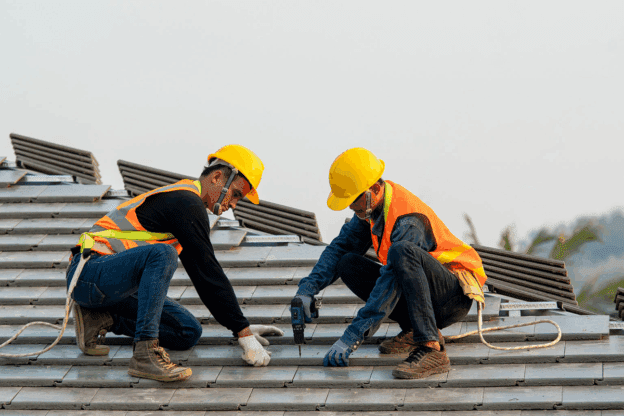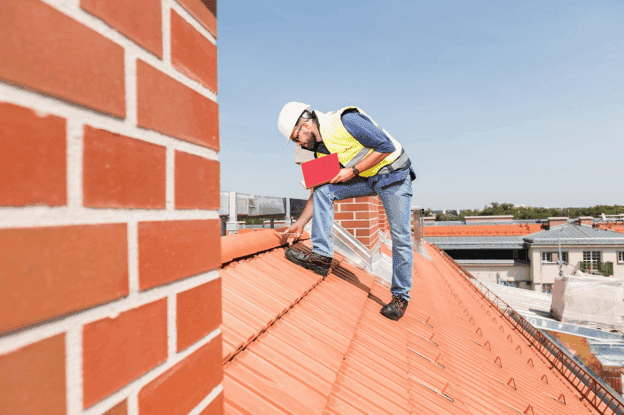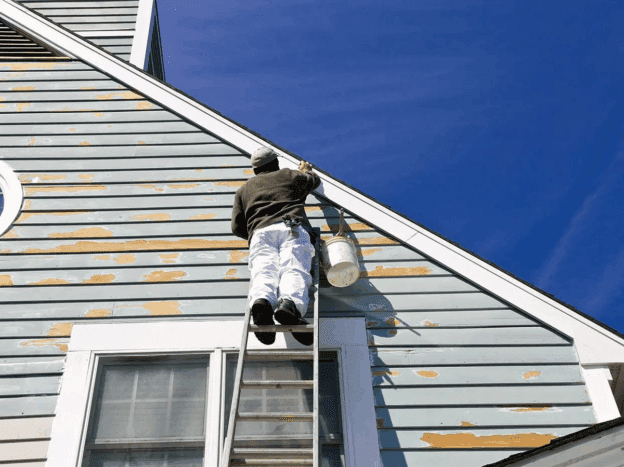
Roof Repair Tips to Keep Your Home Safe and Dry
Keeping your home safe and dry starts with a sturdy roof. Regular roof repair is essential to protect against leaks, water damage, and structural issues that can escalate quickly. Addressing minor problems before they turn into major ones ensures a longer-lasting roof and peace of mind. Homeowners often overlook small signs of damage until it’s too late. From checking for missing shingles to addressing wear and tear, proactive maintenance is key. These roof repair tips will help identify potential issues early, ensuring your home remains secure and comfortable through all seasons.
Inspect Shingles for Signs of Damage
Regularly inspecting shingles for damage is essential to prevent leaks and maintain roof integrity. By identifying issues early, you can address them before they escalate into costly repairs.
- Check for Curling: Look for shingles that are curling at the edges, which can indicate aging or poor installation. Curling shingles are less effective at shedding water and may need replacement.
- Look for Cracking: Inspect for visible cracks in shingles, which can be caused by severe weather or thermal expansion. Cracked shingles compromise the roof’s ability to protect against the elements.
- Examine Granule Loss: Find granules in gutters or on the roof surface. Significant granule loss can signal that shingles are deteriorating and may need to be replaced to maintain effective coverage.
- Identify Missing Shingles: Check for any missing shingles, especially after storms. Missing shingles expose the roof to potential leaks and require immediate replacement to prevent water damage.
- Monitor Discolouration: Look for discoloured patches or stains on shingles, which can be a sign of algae growth or moisture issues. These problems can affect the roof’s longevity and appearance.
Ensuring shingles are in good condition will protect the home from water damage and extend the life of the roof.
Check Flashing Around Roof Penetrations
Flashing is essential for sealing areas where the roof intersects with other structures, such as chimneys, vents, or skylights. Over time, flashing can become loose, corroded, or damaged, leading to potential leaks. It’s important to regularly inspect flashing for any signs of deterioration or gaps that could allow water to seep through.
Properly maintained flashing prevents water from entering vulnerable areas and causing damage to the underlying roof structure. If the flashing is found to be compromised, it should be repaired or replaced to ensure a watertight seal. Regularly checking and maintaining flashing helps safeguard your home against water damage and prolongs the life of your roof.
Clean Gutters to Prevent Water Backup
Clogged gutters can lead to significant problems for your roof and home. When gutters are obstructed by leaves, twigs, or other debris, water cannot flow freely through the downspouts. This can cause water to back up and spill over the sides, potentially leading to roof damage, foundation issues, or even mould growth inside your home. Regular cleaning of gutters is essential to ensure proper water drainage.
Aim to clean gutters at least twice a year, or more frequently if you have overhanging trees. Additionally, installing gutter guards can help reduce the amount of debris that accumulates, making maintenance easier and more effective. Keeping gutters clean helps prevent water damage and extends the life of your roof.
Identify and Seal Roof Leaks Early
Identifying and sealing roof leaks early is vital for preventing extensive damage. Addressing leaks promptly helps avoid costly repairs and keeps your home protected from water damage.
- Inspect for Water Stains: Check your ceiling and walls for water stains or damp spots, which can indicate leaks. Early detection helps target the exact location of the problem.
- Examine Roof Surface: Look for visible signs of damage such as missing shingles, cracks, or holes. Addressing these issues promptly can prevent water from seeping through.
- Check Flashing and Seals: Inspect the flashing around chimneys, vents, and skylights for any gaps or deterioration. Properly sealing these areas prevents water infiltration.
- Test During Rain: If possible, use a garden hose to simulate rain and check for leaks inside the home. This can help locate leaks that are not immediately visible.
- Apply Roof Sealant: Use a high-quality roofing sealant to seal identified leaks. Ensure the sealant is applied correctly and covers all exposed areas to prevent future leaks.
By promptly identifying and sealing roof leaks, you safeguard your home against further damage and maintain a secure, dry living environment.
Maintain Proper Roof Ventilation
Proper roof ventilation plays a crucial role in extending the life of your roof and maintaining a comfortable indoor environment. Ventilation helps regulate the temperature and moisture levels in your attic, preventing issues such as overheating, condensation, and ice dams. Ensure that your roof has a balanced ventilation system, including both intake and exhaust vents, to allow for adequate airflow. Check that vents are not blocked by insulation or debris and that they are functioning correctly. Proper ventilation helps reduce the risk of roof damage and energy inefficiency.
Replace Missing or Broken Shingles
Addressing missing or broken shingles promptly is essential to maintaining the integrity of your roof. Shingles can become damaged due to severe weather, falling debris, or natural wear over time. Missing shingles leave your roof vulnerable to water infiltration, while broken ones can compromise the roof’s protective layer.
Regularly inspect your roof for any damaged or missing shingles and replace them as needed. Ensure that the replacement shingles match the existing ones in both colour and type to maintain a uniform appearance. Replacing damaged shingles not only prevents leaks but also helps to avoid more significant issues such as structural damage or mould growth. Keeping your shingles in good condition is a key aspect of roof maintenance.
Address Roof Moss and Algae Growth
Moss and algae growth on your roof can lead to several problems, including premature deterioration of roofing materials and reduced curb appeal. Moss thrives in shady, damp areas and can trap moisture against the roof, leading to damage over time. Algae, often appearing as dark streaks, can also contribute to roofing issues.
To address these problems, regularly clean your roof using a gentle, non-abrasive method. Consider using a roof-safe cleaner or a mixture of water and mild detergent to remove moss and algae. Taking these steps to manage moss and algae helps to maintain the longevity and appearance of your roof.
Secure Loose Roof Tiles or Shingles
Loose roof tiles or shingles can be a sign of underlying issues or simply the result of wear and tear. If left unattended, loose tiles can lead to leaks and further damage. Regularly inspect your roof for any tiles or shingles that may have become dislodged or loose. Secure them by either re-nailing or replacing them as necessary.
It’s important to address these issues promptly to prevent water from seeping under the roof and causing more significant damage. Properly securing roof tiles and shingles ensures that your roof remains intact and continues to provide effective protection for your home.
Examine Roof Valleys for Issues
Roof valleys are critical areas where two sections of the roof meet and water flows down into the gutters. They are often prone to leaks if not properly maintained. Regularly examine roof valleys for signs of damage or wear, such as missing shingles, cracks, or debris accumulation. Ensure that the flashing in these areas is intact and free from rust or corrosion. Proper maintenance of roof valleys is essential to prevent water from penetrating and causing damage to the roof structure.
Ensure Proper Insulation and Venting
Proper insulation and venting are crucial for maintaining a healthy roof and home environment. They help regulate temperature, prevent moisture issues, and improve energy efficiency. Here’s how to ensure everything is in top shape:
- Check Insulation Levels: Ensure insulation is evenly distributed across the attic to prevent heat loss and maintain indoor comfort. Insufficient insulation can lead to higher energy bills and temperature fluctuations.
- Verify Ventilation: Make sure attic vents are clear and functional. Proper ventilation prevents moisture buildup and reduces the risk of ice dams and mould growth, extending the roof’s lifespan.
- Seal Gaps: Inspect and seal any gaps in insulation or around vents. Gaps can lead to drafts and reduce the effectiveness of both insulation and ventilation systems.
- Inspect for Blockages: Regularly check for and remove any debris blocking vents. Blockages can impede airflow, leading to overheating and moisture issues that compromise the roof.
- Upgrade as Needed: Consider upgrading insulation or venting systems if they are outdated or insufficient. Modern solutions can significantly improve energy efficiency and overall comfort.
Ensuring proper insulation and venting not only enhances the roof’s durability but also contributes to a more comfortable and efficient home.
Maintaining a well-repaired roof is essential for keeping a home safe and dry. Regular inspections and timely repairs, such as addressing damaged shingles, checking flashing, and cleaning gutters, are crucial for preventing costly issues. By staying on top of roof maintenance, issues like leaks, poor ventilation, and moss growth can be managed effectively, ensuring long-term protection for the home.
For expert assistance with roof repair, Tidal Remodeling is here to help. Whether it’s fixing leaks or replacing shingles, rely on experienced professionals to keep your roof in optimal condition. Contact Tidal Remodeling at +1 (760) 990-7890 for a consultation and safeguard your home today.



